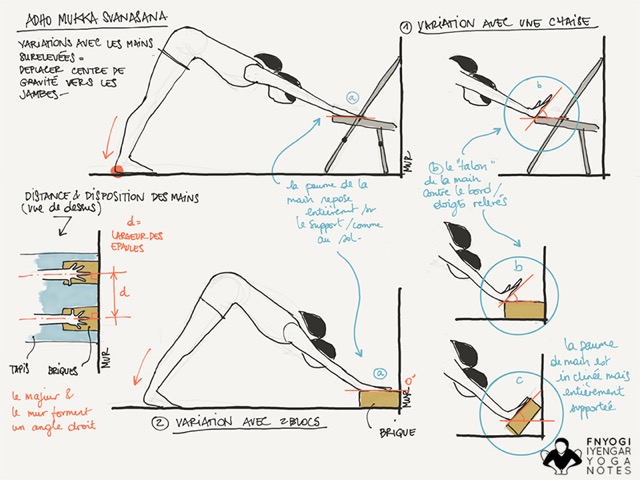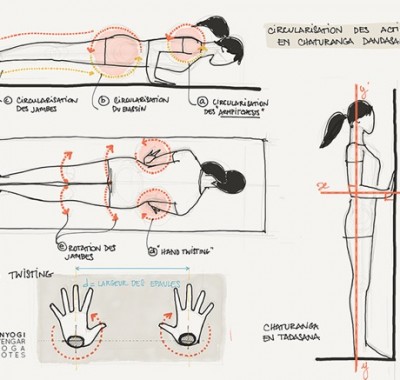Dessislava did me the honor of making a little place for my sketches on her diary. The purpose of this section is to present a modified posture using bricks, straps, blankets or other props to enhance a given effect in an asana, or by example to work a posture in spite of specific difficulties. In fact, this is what we do all the time in yoga Iyengar classes ! But we want here further detail with the help top or side drawn views which have the advantage to be less personal than pictures and also more didactic. The drawings which come with each article represent the modified posture and its possible sub-variations. Therefore, I repeat the precautions that accompany the articles on my own blog [http://www.iyengaryoganotes.com]: these notes are not a tutorial! They only bind me, They are the fruit of my notes and observations and only the reflection of my understanding. I hope they will encourage you to experiment for yourself.
Move the center of gravity to the legs in Adho Mukha Svanasana
This article is the first in a series devoted to an essential asana: Adho Mukha Svanasana, the posture of the dog head down. In this post, we discuss the action of raising hands with various accessories. But first of all let’s look at the effects of Adho Mukha Svanasana, according to BKS Iyengar. In the “Yoga Bible” it is written that “when one is exhausted, a prolonged station In this posture eliminates the fatigue and allows to recover the lost energy <…> … hum, hum! it may be true for an assiduous yogi, but it is not at all the impression given to me by my beginners students who just collapse – exhausted – after a few breaths in Adho Mukha Svanasana and long before they have the leisure to “recover the lost energy”.
It is therefore a good introduction to this variation with the hands more or less elevated compared to the feet: because it presents the huge advantage of moving the weight to the legs, relieving the hands, wrists, arms and shoulders for those who do not have the necessary training or suffer. The higher the hands, the easier it will be to maintain the posture for a long time while benefiting from its positive effects.
First variation: Using the chair
In this variation, which one could almost qualify as a “preparation”, one places a chair against a wall and the palms of hands are placed flat on the seat. This makes it possible to lower the heels to the ground while keeping the legs stretched, even for those who have super shortened hamstrings.
As the center of gravity is transferred to the legs, this greatly relieves the work from the top of the body, and we automatically obtain a better extension of the whole trunk, from the hands to the buttock bones.
Second variation: hands on blocks
In this variation, we approach the final posture: two blocks are placed flat against the wall.
The hands are therefore raised only a few centimeters higher the feet. That’s all similarly sufficient to relieve the work of the arms and shoulders and extend the station in the posture. Here, we learn to lower the internal heels and enhances activation of the legs from the root of the thighs, this time, to actively carry the weight backwards and obtain a “active” elongation of the sides of the trunk.
Reminder: The position of the hands
The hands are flat, the middle finger in the direction of the wall, shoulders width apart.
But in addition to flat hands (a) the drawing shows two other possibilities to place your hands:
b) hands on an inclined block: has the effect of raising the forearms. This variation is restful for the arms and for those who have a tendency to hyperflexibility of the elbows.
c) by pressing the “heel of the hand” and raising the palm and the fingers: as my teacher says, it is a “boney action” (one could translate as “bone action”) – the palm of hand is not supported – the heel of the hand is against the edge of the brick or the seat of the chair.
In addition to activating the palm and fingers, this variant has the effect of connecting the joints together as if we connect dots with lines on a drawing. This allows a clear action of the wrist towards the shoulder.
References : Light on yoga (BKS Iyengar)
A chair for yoga / Props for yoga (Eyal Shifroni)
You can find Fanny also on her own blog Iyengar yoga notes – http://www.fnyogi.com


